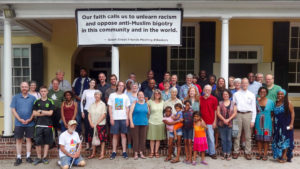
When the Israelites fled Egypt, they were demanded by God to take reparations, Rabbi Aryeh Bernstein argues.
After generations of enslavement in Mitzrayim, before their long trek to the land of milk and honey, the Israelites were instructed to take back gold and their wealth; the Torah states, “Afterward shall they come out with significant property.”
To Bernstein, the story of God demanding that Israelites take back wealth from the ancient Egyptians is a central part of the story of Exodus.
Though a midrash from centuries ago, Jewish conversations about reparations — compensation for past harm, loss or damages — have bubbled to the surface in the modern-day reckoning many predominantly white institutions and individuals are having about racism in the United States.
For the Jewish leaders in Philadelphia that are starting conversations about reparations in their communities, beginning the process of giving reparations to Black Americans is urgent.
“My people are dying; my community [of Jews of color in Philadelphia] is struggling,” said Jared Jackson, founder and executive director of Jews of color advocacy organization Jews In ALL Hues. “So while you’re waiting to feel benevolent, our lives are diminished until you feel the need to say whatever words you need to say to yourself and others to get the ball rolling.”
On Juneteenth, Jackson, as well as Reconstructing Judaism’s Director of the Center for Jewish Ethics Rabbi Mira Wasserman represented the Jewish community at the Mayor’s Commission for Faith-based and Interfaith Affairs, in partnership with POWER Interfaith, the Truth Telling Project and Philadelphia Yearly Meeting.
Jewish, Christian and Muslin faith leaders met as a call to action for religious groups to give reparations to Black descendants of enslaved people. Religious spaces offer the opportunity to talk about the underlying values that drive the practice of reparations.
“You don’t have faith traditions without people,” Jackson said.
In Philadelphia, there’s a push among reparations proponents to resolve tangled titles — which makes home ownership unclear by not guaranteeing the deed to one’s home is passed down to their intended heir if they do not have a will — an issue by which Black and brown Philadelphians are disproportionately affected, Jackson said.
Reparations can take the form of funding legal aid for those looking to protect their home ownership.
But persistent racism can be identified even within Jewish spaces, Jackson said. He uses the example of Jews In ALL Hues to show the past complacency of the predominantly white Jewish community to address monetary inequity.
Jews In ALL Hues relies on private donors and grant money to continue business, Jackson outlined. Other organizations hire Jews In ALL Hues to conduct diversity, equity and inclusion workshops, which also help support programming. Though Jackson calls the nonprofit the oldest organization of its kind serving Jews of color, Jews In ALL Hues does not receive funding from the Jewish Federation, he said.
Instead, many Jewish organizations hold workshops about race and racism or invest in initiatives and task forces to conduct research on racism in the Jewish community, Jackson said. These growing efforts, even in multiracial groups, are often helmed by white people and do not fully take into consideration the needs of the people of color they intend to help. In some other cases, even when Jews of color lead anti-racism efforts, they have to balance their own emotional needs with the work in which they lead their white counterparts.
“We need more than just people, mostly white people, studying us,” he said.
Though Jackson advocated for better funding of efforts led by Jews of color to address racism and build community, he’s quick to differentiate between funding and reparations.
“It’s beyond the dollar you put in your JNF box,” he said.
When organizations fund Jews of color-led efforts, similar to philanthropy, they receive a return on their investment in the form of a tax deduction of community programming the organization can hold with increased funding.
With reparations, white institutions and individuals must give back to people of color with the trust that the recipients will use the money for what they need it most, which may be invisible to the reparations giver, or it may not align with the giver’s values or agenda.
“If you’re giving reparations to Jews of color, the people to decide where the money is going, the people to decide the process, the distribution, all have to be Jews of color,” Jackson said. “There needs to be that trust that we will make the right choices for us, in a way that will look different than what white supremacy tells us is professionalism or philanthropic excellence.”
Before monetary reparations are given, there must first be teshuvah, Wasserman said.
Within the Jewish community, there must be an understanding of the harm inflicted on a group of people to know how to address it.
For the white Jewish community, this process is hard, Wasserman said. To begin with, many Jews don’t know about reparation efforts in the larger political climate. Others may not fully grasp the breadth and depth of anti-Black racism or don’t see addressing it as a Jewish issue.
Being a group that also experiences discrimination adds to the challenges of recognizing and addressing racism, Wasserman said.
“We have lots of concerns about antisemitism that take up a lot of our attention and energy,” she said.
In white Jews’ efforts to combat antisemitism, they can forget that anti-Jewish hatred comes from the same white supremacist roots as anti-Black hatred, Wasserman argues.
“In a sense, anti-Black racism and antisemitism are just sort of two faces of white supremacy and white nationalism in this country,” she said.
Before the recent Jewish interest in reparations for Black Americans, Jews tackled the topic of reparations after the Holocaust. Even then it was met with mixed opinions.

In 1952, Israeli and German officials signed the Reparations Agreement between Israel and the Federal Republic of Germany, in which West Germany was to give money and resources to the budding state of Israel. Germany would also give payments to Holocaust survivors and direct descendants of survivors through the Conference on Jewish Material Claims Against Germany.
While German officials and citizens were either in favor of or indifferent to reparations, Israel had some of the most significant opposition to reparations, according to Thomas Craemer, a University of Connecticut professor of public policy who studies reparations.
Jews worried that accepting reparations from Germany would mean that the trauma and pain from the Holocaust would be “fixed” — addressed enough for Germany’s hands to be wiped clean of the genocide.
Wasserman uses the example of the Holocaust to point out that reparations go beyond just the individual receiving compensation.
“The reparations aren’t only for victims but for the whole society to recognize the wrongs and the society’s complicitness in wrongs,” Wasserman said.
“I get the feeling that reparations probably do have the power to change perspectives and repair relationships,” Craemer added.
Even after overcoming ideological barriers to address reparations, Americans have become paralyzed with how to practically approach reparations.
Members of Green Street Friends, a Quaker meeting, shared their blueprint for giving reparations in the Philadelphia area at the Juneteenth interfaith event.
“Our meeting house is located in Germantown, which is a predominantly Black neighborhood where the average household income is below the poverty line, but most of our members are upper-middle class white,” said Afroza Hossain, a founding member of the Green Street Reparations Committee. “So it felt like a very personal thing for our meeting to make reparations and repair some of the wounds of racial injustice that have been done in this country historically.”
Quakers draw on a similar value as teshuvah, using the value of “repair” to guide their reparations movement. They have had to undergo their own reckoning with racism as a predominantly white institution; William Penn, a Quaker who founded Quakerism in the commonwealth, owned enslaved people.
The meeting made a 10-year plan to give $500,000 in reparations over the next 10 years. For the past six months, the meeting held six legal clinics at the meeting house, partnering with Philadelphia VIP and providing pro bono legal counsel for Black residents. They give money to residents who need home repairs.

The goal is to keep Black residents who have lived in the neighborhood for generations from being displaced. The Black members of the meeting decided on the effort to invest in this past year and will be the only meeting members to decide where reparations go, Hossain said.
Hossain believes that reparations is an active process. While larger bodies like corporations can give money, their ability to invest time and emotions into the practice of repair is limited. The “holy” nature of reparations — its foundation on community, trust and repair — is what makes it an obligation for faith-based organizations.
“This is spiritual work,” she said.






